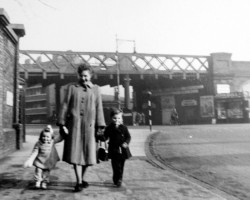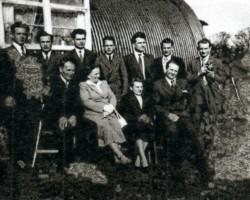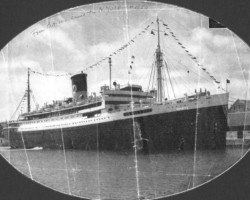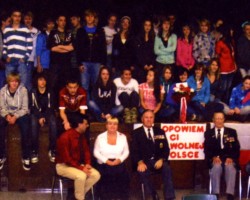The post-war fates of the soldiers of 2nd Corps
Dr. Hab. Tadeusz Kondracki (professor at the Institute of History of the Polish Academy of Sciences)
May 8, 1945 was not a day of victory for Poland. Many units of the 2nd Corps issued orders not to celebrate the end of the war too ostentatiously, which for Poland ended with a new occupation. This was understandable, especially for soldiers from the eastern provinces of the Republic. Against this background, there were mental crises and even suicides.
The personal dramas were compounded by the drama of the Polish cause, betrayed by its allies. In connection with the recognition by the British government of the so-called Provisional Government of National Unity imposed by Moscow (which was associated with the withdrawal of recognition of the legal Government of the Republic of Poland), on July 6, 1945, the Polish ambassador Edward Raczyński issued a historic note to the British. In it, he protested “against the recognition by the British government of a government imposed by force by a foreign power, which – as he emphasized – is tantamount to recognition of the deprivation of Poland’s independence.”
In the existing situation, in the summer of 1945, with the approval of the Chief of Staff of the Polish Armed Forces, General Stanisław Kopański, the beginnings of a mass social organization of Polish veterans were created in London under the name of Samopomoc Wojska (Military Self-Help), renamed in 1946 to the Polish Combatants’ Association. It is characteristic that until June 1946 General W. Anders did not allow the creation of SW (SPK) cells in the units of the 2nd Corps, which at that time he justified with the need to maintain the cohesion of the Corps and protect it from “demobilization” moods.
On the contrary, the 2nd Corps, until mid-1946, was still treated by its commander as an important military and political factor that had to be maintained in combat readiness in the event of a possible Soviet invasion of Italy. These preparations (for example, field exercises or exercises in the field of recognizing Soviet equipment) lasted until the last weeks of the Polish army’s stay in Italy. Another element of preparations for the expected fight with the USSR was the expansion of the 2nd Corps by the multitudes of Poles conscripted into the German army, or imprisoned in camps in Germany, including many soldiers of the Home Army. While on 1 May 1945 the strength of the 2nd Corps was 81 thousand soldiers, on 1 August it was already 113 thousand (i.e. over 30 thousand people more).
Many factors distinguished the 2nd Corps from the units of the Polish Armed Forces that traced their lineage to the 1st Corps of the Polish Armed Forces in Scotland. “The 2nd Corps is a large society,” a journalist from the weekly “Defilada” pointed out. “Its agencies cover three parts of the world, operating [outside of Europe] also in Asia and Africa. The 2nd Corps has something that could be boldly called the Ministry of Social Welfare. The rule is that a soldier cannot worry about his family if this family is within the Corps’ range of operations. Social welfare is organized excellently. Also, every Pole in Italy can count on the army not to let him starve. In addition to welfare, there is education, organized by the army in three parts of the world, military and civilian schools of all levels, specialist and general education.”
General W. Anders expressed his political credo in an order to soldiers on July 6, 1945: “We must wait in close, disciplined ranks for a favorable change in conditions. This change must come.” These calculations failed when in May 1946 the British government decided to demobilize the Polish Armed Forces, including the 2nd Corps, and transfer the soldiers to civilian life through a British institution, the Polish Resettlement and Resettlement Corps (PKPR).
The decision to demobilize caused widespread outrage in the units. The 5th Kresowa Infantry Division protested the most. The so-called “Sulik mutiny” (named after the commander of the 5th KDP) occurred. Ideas of taking action – even armed – against the British appeared. General Anders, like no one else, was aware of the moods of his soldiers. However, for political reasons, he called for tempers to be tempered and for demobilization to be submitted. He argued that the Polish Communist Party was giving the Poles two more years in close formations. The most important thing, however, was not to take action against current, and probably future, allies. As General Zygmunt Bohusz-Szyszko, a close associate of General Anders, put it: “We are supposed to be with them [the British], not fight them.”
One of the consequences of the decision to demobilize the 2nd Corps was the order of General Anders of June 18, 1946, authorizing the creation of SPK circles in the Corps units. In the existing situation, the general treated them as an important ideological and political factor in continuing the fight for Poland. This motive was clearly present in the opening statement of the chairman of the Central Organizational Committee of the SPK Unit “Syrena” (from the Corps’ badge) being created in the 2nd Corps, Lieutenant Colonel Bolesław Brochwicz-Lewiński, on July 8, 1946: “the hidden goal of the organization – the fight for Independence by gathering, organizing and directing military emigration in the social and organizational plane. Providing support for the Government”.
The transfer of the 2nd Corps units to Great Britain, by sea and rail, lasted from spring to winter 1946. The new country was a great unknown for almost everyone. “The ships from Italy are tragically quiet,” wrote Ryszard Kiersznowski, “(…). On all decks, heads together, soldiers of the 2nd Corps, staring at the English shore. The orchestra plays on the pier, but from the deck no one gives joyful hand signals, no one waves handkerchiefs. Only the English sailors, leaning out of the windows, rejoice and shout over each other. The Poles are silent, immersed in complete apathy.” The stress associated with the sudden change of the previous environment and the uncertainty of tomorrow was deepened by the critical reactions of some of the British press towards the 2nd Corps, following the expectations of Soviet propaganda. The article “Beware of Anders’ Poles!”, published in the “News Chronicle” on August 20, 1946, included the following: “Our compassionate hospitality towards Anders’s people (…) jeopardizes our relations with the new Poland [i.e. communist Poland under Moscow’s control – Constitutional Tribunal] and increases Russia’s skepticism regarding British assurances of good will towards the Soviets [sic!]”.
In the new stopovers of the Corps units in the British province, from southern England to Scotland, the event of the day was the registration for the Polish People’s Army. A difficult passage for the soldiers of General Anders, who had arrived from warm Italy, was the first exceptionally harsh winter on British soil. The insufficient food rations were criticized. In the era of restrictive rationing, there was no shortage of complaints about the difficulties in buying products, due to – unlike in Italy – the lack of a free market for food products.
However, the fate of Poland and the future of the soldiers themselves were much more serious. A large part of them faced a dilemma – to remain in the units or return to a country deprived of freedom. The soldiers who decided to return the fastest and in the largest numbers were those who were recruited from German POW camps in the last years of the war.
The fates of those who returned to Poland were very different. Some of them – as “Anders’ men” – were persecuted for years by the communist security apparatus. Some, like Capt. Witold Pilecki, despite their outstanding services to the country, were murdered. Too many, treated as second-class citizens; instead of proof of respect, they experienced humiliation and privation, and often poverty.
The fate of those soldiers who – mainly for family reasons – returned to the territories annexed by the USSR was dramatic. In addition to daily harassment, they were soon to experience new deportations. On the night of 31 March to 1 April 1951, all of them were arrested by the Soviet political police (NKVD) and, together with their families and without their belongings, exiled to Siberia, to the Irkutsk taiga. The title of the memoirs of Józef Kołtan, a former soldier of the 15th Poznań Uhlan Regiment, is telling in this respect: “From the Arkhangelsk Taiga to the Irkutsk Taiga via Monte Cassino”. It was only years later that these exiles were granted the right to return to their homelands in the Borderlands. Some managed to leave for the Polish People’s Republic.
The Soviet authorities, as well as the authorities of the “People’s” Poland, had a special hatred for the commander of the 2nd Corps, General W. Anders. In September 1946, both he and a large group of commanders of the Polish Armed Forces (including the 2nd Corps) were stripped of their Polish citizenship by the communist government in Warsaw – by the law of escrow. In the later propaganda guidelines, from September 1950, aimed at making the general look bad, they pointed out, among other things, his allegedly “fascist political face (anti-Semitism, Hitlerite methods in the army, linking political calculations to Hitler’s victory, persecution of democrats)”. There was an unambiguous suggestion that documents were being fabricated to prove that General Anders had been conducting espionage for Germany during the war.
The vast majority of the soldiers of the 2nd Corps, who had passed through Russia and remembered the methods of the NKVD, remained in the West. Many emigrated further – across the Atlantic, mainly to the USA and Canada, and in South America to Argentina. Some, mainly married to Italian women, remained in Italy. It was largely on their shoulders that the duty of caring for the Polish war cemeteries and monuments established there, commemorating the armed deeds of the Corps, rested. Special ties forever connected the veterans of General Anders with the place of their greatest combat glory, but also with the sacrifices expressed by the name-symbol: Monte Cassino.
The soldiers of the 2nd Corps who decided to stay in Great Britain gradually – until 1948 – left the PKPR camps, moving to civilian life. They settled mainly in large cities in central and northern England (including Wales), with developed industry, where there were the greatest employment opportunities. This was a time when it was necessary to take up jobs, mainly physical ones, for which there was the greatest demand, e.g. in mining. For officers, most often without a civilian profession acquired in Poland, retraining and looking for work often involved severe social degradation. Much was said about the so-called “silver brigade” – a group of officers who specialised in cleaning hotel silverware. Others cleaned shoes or ironed wardrobes, etc. The former deputy commander of the 5th KDP, General Klemens Rudnicki, founded an antique shop in London and was involved in the restoration of paintings.
In their new places of residence, the veterans gathered in groups of friends originating from military units, or in circles of the Polish Combatants’ Association (SPK). They took care of the development of Polish education; of passing on to the younger generation – born abroad – the values and goals to which they themselves had always remained faithful. It was their daily work and social activity that built the authority of Poland and Poles in local communities in England, Wales and Scotland for decades.
In 1951, every third Polish immigrant lived in London. The main Polish concentration there was the so-called “Polish Corridor”, in the area of Kensington, West Brompton and Earl’s Court. In January 1954, the former commander of the 5th KDP, General Nikodem Sulik, was bid farewell to the former commander of the 5th KDP. The feelings of the Kresowiacy during the days of mourning were most clearly expressed in a poem by Józef Bujnowski:
“Your body was not given to a tow truck,
General, and the eagles do not roar
over your coffin stripped of your homeland.
Neither the trees nor the whisper of home
fate did not allow for the last hour.
(…)”
Along with the army, the 2nd Corps’ magazine “Orzeł Biały” (White Eagle) travelled to the British Isles, alongside the unit bulletins. Over time, it was widely considered to be “the leading, political, peaceful, and last cohesive unit of the 2nd Corps”. Gen. Anders’ veterans always worked to help the homeland and their compatriots. This was the case, for example, in April 1956, during the protest action related to the visit to Great Britain of the USSR leaders Khrushchev and Bulganin. On 22 April, around 20,000 Poles, including many of Gen. Anders’ soldiers, marched through the streets of London to the Cenotaph on Whitehall, in protest against the imprisonment of thousands of their compatriots in the USSR. Following this action, the head of the British Foreign Office (MSZ) Selwyn Lloyd received Gen. Anders and Ambassador E. Raczyński the following day. This was the first official meeting of a member of the British government with the leaders of the emigration since the end of the war.
Gen. Anders, until his death, on the anniversary of the beginning of the Battle of Monte Cassino, on May 12, 1970, remained the undisputed leader of the emigration; the highest authority for his former subordinates and most of the Polish political emigrants, as well as for Poles in the country. When he died, he was buried among his soldiers at the Polish Military Cemetery at Monte Cassino.
The news of the death of the commander of the 2nd Corps has brought deep mourning to Polish communities all over the world. Under its influence, on May 13, in Chicago, Feliks Konarski (Ref-Ren), the author of the lyrics to the song “Czerwone maki na Monte Cassino”, wrote a moving poem “Na śmierć Generała”, from which the following fragment is taken:
“Soldier lost in the Asian winter,
In the desolate taigas of Komi, in the tundras of Kolyma,
Enslaved, hounded, stripped of illusions,
Wasted by scurvy, eaten away by decay…
Pray today for the One who with his hands
He then led you out of this inhuman land
Humiliation and filth, shame and rot,
So that you can stand again in the service of the Fatherland…”
Former soldiers of the 2nd Corps have always been the core of the most important veterans’ organization – SPK, both in Great Britain and in other countries of settlement. Many activists of the Association came from the ranks of the 2nd Corps, including several presidents of the Great Britain Branch of SPK, including Stefan Soboniewski, Czesław Zychowicz and Mieczysław S. Jarkowski.
In SPK, the London Circle No. 316 was exceptional in many respects, grouping mainly women soldiers of the 316th Transport Company of the Women’s Auxiliary Military Service (PWSK) of the 2nd Corps. Its long-term president was Danuta Gradosielska. The active social work of the members of Circle No. 316 was a continuation of the service for Poland of women soldiers; a service whose essence was expressed for years in a stanza born on the roads of Italy:
“Because we are from transport, because we are from transport
we do it for a holy cause,
not for sport.”
In addition to the SPK structures, there were also numerous unit circles of units, grouping former soldiers of the 2nd Corps. They were concentrated, among others, within two particularly numerous and active unions of unit circles of both infantry divisions of the 2nd Corps – the 3rd Carpathian Rifle Division and the 5th KDP.
In 1981 and later, the veterans of the Corps living in Great Britain and other countries of settlement generously helped their compatriots in Poland, struggling with the effects of martial law and the widespread shortages resulting from the collapse of the Polish People’s Republic economy. This help – both financial and material – concerned hundreds of veterans of the Corps and their family members, as well as thousands of other compatriots.
The 2nd Corps veterans living in Poland were deprived of the opportunity to freely proclaim the truth about the 2nd Corps, or even to freely associate for years. The authorities of the Polish People’s Republic only allowed membership in the licensed Union of Fighters for Freedom and Democracy (ZBoWiD). The political police, from 1956 under the name of the Security Service, fought against any attempts to self-organize or question the monopolistic position of ZBiWiD (numerous especially in the 1980s). There were arrests, independent meetings, celebrations and other veterans’ events were monitored (including recording speeches), participants were followed and photographed, car numbers were written down and registered for further investigation, warning conversations were held, etc. The political attitude and actions of those veterans of the 2nd Corps who were members of ZBoWiD were closely monitored. The Church remained the stronghold of independent veterans’ activity during the Polish People’s Republic, which was more active with each passing year.
For obvious reasons, the communist authorities did not allow the propagation of the full history of the 2nd Corps, free from any concealments. In the first period after the end of the war, mentioning the battles, especially at Monte Cassino, was still allowed. Later, in the most repressive phase of Polish Stalinism, one could be imprisoned for simply mentioning the actions of the 2nd Corps or corresponding with its soldiers living in the West. After the thaw of 1956, there was a certain opening of possibilities for publishing about the battles of the 2nd Corps, but censorship regulations did not allow, for example, positive writing about General Anders. A similar policy was implemented in education (presenting the heroism of ordinary soldiers was allowed, while the political attitude of the command was stigmatized). In those years, unfettered knowledge about the role of the 2nd Corps and its commander in the history of Poland was obtained from foreign radio stations (especially from “Wolna Europa” and “Głos Ameryka”), as well as from emerging independent publications. Families played an important informational and educational role in this area. The subject matter, kept under relative control by the authorities of the Polish People’s Republic, through censorship regulations, saw the light of day in an unrestricted way during the “Solidarity” revolution in 1980-1981. The mass “second circulation” of books and magazines that was established at that time effectively bypassed all censorship restrictions.
From the very beginning, soldiers of the 2nd Polish Corps played leading roles in creating the foundations of “Poland outside Poland” in exile and in activities (both in Poland and in exile) aimed at restoring the independence of the Homeland.
As always, they remained faithful to the words of the “Declaration of the Soldiers of the 2nd Corps” – an oath taken in Italy on June 15, 1946, on the graves of their fallen colleagues:
“United with the aspirations of the entire Nation, both at home and abroad, we vow to continue to fight for Poland’s freedom, regardless of the conditions in which we will have to live and act.”
Exhibition Materials






























Photographs








